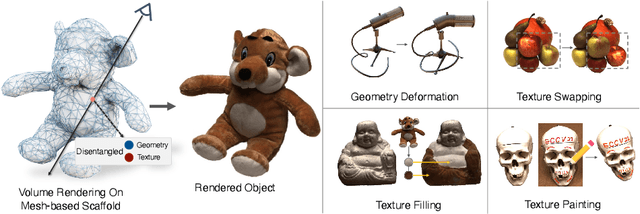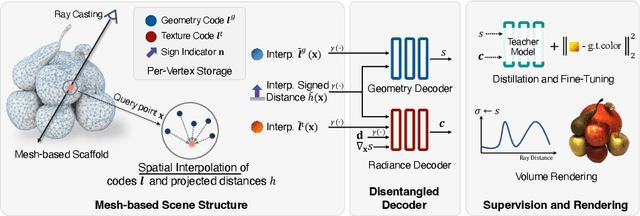Junyi Zeng
Mirror-NeRF: Learning Neural Radiance Fields for Mirrors with Whitted-Style Ray Tracing
Aug 07, 2023Abstract:Recently, Neural Radiance Fields (NeRF) has exhibited significant success in novel view synthesis, surface reconstruction, etc. However, since no physical reflection is considered in its rendering pipeline, NeRF mistakes the reflection in the mirror as a separate virtual scene, leading to the inaccurate reconstruction of the mirror and multi-view inconsistent reflections in the mirror. In this paper, we present a novel neural rendering framework, named Mirror-NeRF, which is able to learn accurate geometry and reflection of the mirror and support various scene manipulation applications with mirrors, such as adding new objects or mirrors into the scene and synthesizing the reflections of these new objects in mirrors, controlling mirror roughness, etc. To achieve this goal, we propose a unified radiance field by introducing the reflection probability and tracing rays following the light transport model of Whitted Ray Tracing, and also develop several techniques to facilitate the learning process. Experiments and comparisons on both synthetic and real datasets demonstrate the superiority of our method. The code and supplementary material are available on the project webpage: https://zju3dv.github.io/Mirror-NeRF/.
NeuMesh: Learning Disentangled Neural Mesh-based Implicit Field for Geometry and Texture Editing
Jul 25, 2022



Abstract:Very recently neural implicit rendering techniques have been rapidly evolved and shown great advantages in novel view synthesis and 3D scene reconstruction. However, existing neural rendering methods for editing purposes offer limited functionality, e.g., rigid transformation, or not applicable for fine-grained editing for general objects from daily lives. In this paper, we present a novel mesh-based representation by encoding the neural implicit field with disentangled geometry and texture codes on mesh vertices, which facilitates a set of editing functionalities, including mesh-guided geometry editing, designated texture editing with texture swapping, filling and painting operations. To this end, we develop several techniques including learnable sign indicators to magnify spatial distinguishability of mesh-based representation, distillation and fine-tuning mechanism to make a steady convergence, and the spatial-aware optimization strategy to realize precise texture editing. Extensive experiments and editing examples on both real and synthetic data demonstrate the superiority of our method on representation quality and editing ability. Code is available on the project webpage: https://zju3dv.github.io/neumesh/.
 Add to Chrome
Add to Chrome Add to Firefox
Add to Firefox Add to Edge
Add to Edge